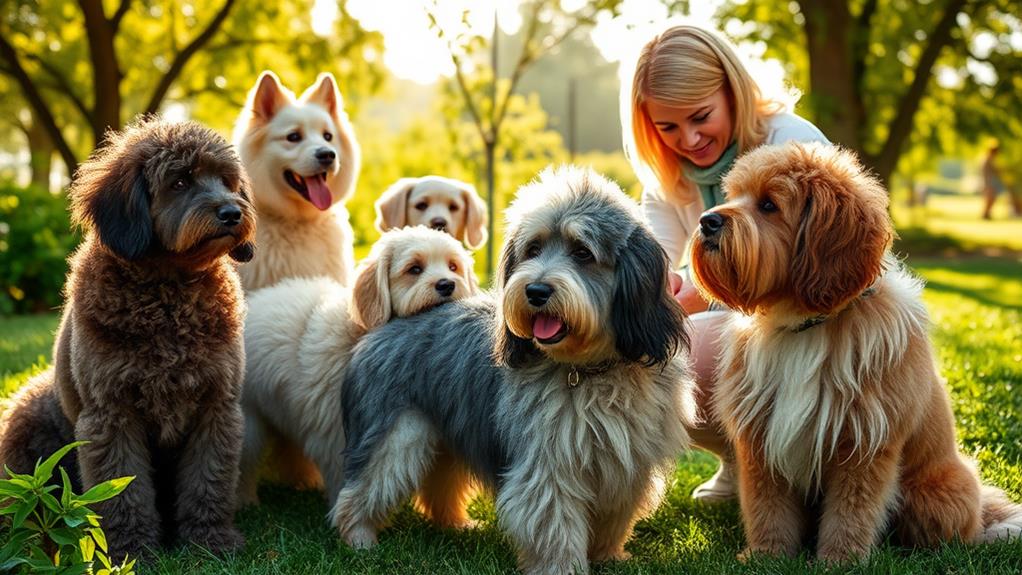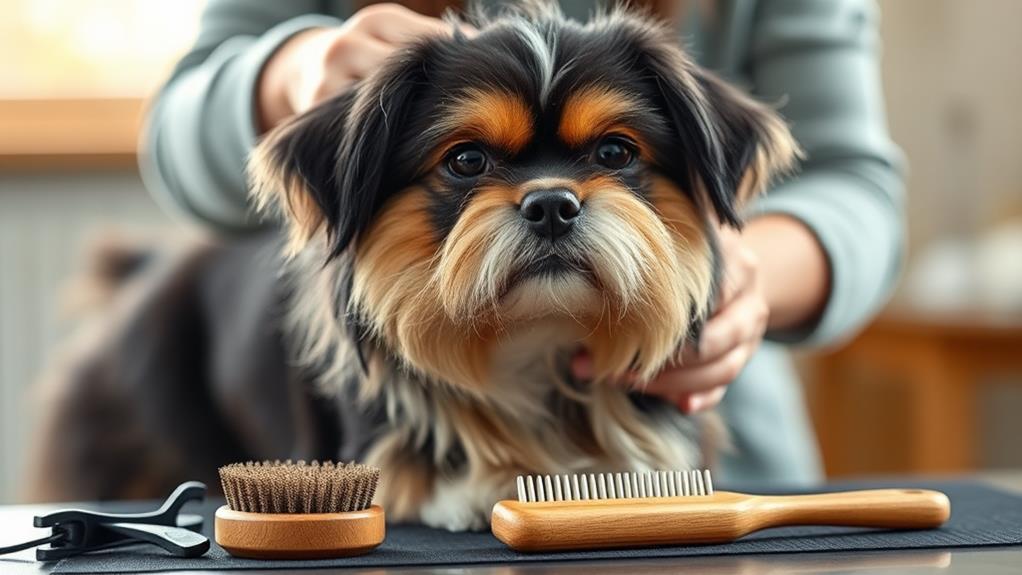To effectively groom your double-coated dog, you'll want to use the right tools like an undercoat rake and slicker brush. Brush at least once a week, and more often during shedding seasons, to remove loose fur and prevent matting. Bathe with a mild, dog-specific shampoo in lukewarm water, rinsing thoroughly to maintain their natural oils. Regularly inspect your dog for skin issues or signs of irritation. Adjust your grooming routine seasonally to keep their coat healthy and comfortable. Want to learn more about tailored grooming techniques for your furry friend? There's so much more to explore!
Understanding Double-Coated Breeds

Double-coated breeds, like the Siberian Husky and Golden Retriever, have two layers of fur: a soft undercoat that provides insulation and a coarser outer coat that protects against the elements. Comprehending how these layers function is vital for effective grooming.
The undercoat acts like a thermal barrier, keeping your dog warm in winter and cool in summer. It's designed to shed seasonally, which means you'll notice more fur around your home during the shedding periods.
When you groom your double-coated dog, you'll want to pay attention to both layers. The outer coat repels dirt and moisture, but it can also trap loose fur and debris. Regular brushing helps remove this buildup, preventing matting and promoting a healthy coat. It's necessary to choose the right techniques to avoid damaging the undercoat, which can be sensitive.
Keep an eye on your dog's skin health, too. The undercoat can hold moisture, leading to skin issues if not properly maintained. Overall, understanding the unique structure of double-coated breeds will help you provide the best care for your furry friend, ensuring they stay comfortable and healthy year-round.
Essential Grooming Tools

When grooming your double-coated dog, having the right tools on hand can make all the difference. These breeds require special care, and using the appropriate grooming tools guarantees you maintain their coat's health and appearance.
- Undercoat Rake: This tool is essential for reaching through the top coat to remove loose, dead fur from the undercoat. It helps prevent matting and keeps shedding manageable.
- Slicker Brush: A slicker brush is excellent for removing tangles and debris from the top coat. Its fine bristles can reach deep into the fur, making it perfect for smoothing out any knots.
- De-shedding Tool: During shedding seasons, a de-shedding tool can be a lifesaver. It effectively removes loose fur without damaging the coat, helping you keep your home fur-free and your dog comfortable.
With these tools, you're well-equipped to handle your double-coated dog's grooming needs. Regular grooming will keep their coat healthy and reduce shedding, making both you and your dog happier!
Frequency of Grooming Sessions

Grooming sessions for your double-coated dog should ideally occur every 4 to 8 weeks, depending on the breed and individual coat type. Keeping a consistent grooming schedule helps manage shedding, prevents matting, and maintains the health of your dog's coat.
Here's a helpful guide to determine how often you should groom based on your dog's characteristics:
| Breed Type | Recommended Frequency | Notes |
|---|---|---|
| Heavy Shedders | Every 4 weeks | Requires more frequent attention. |
| Moderate Shedders | Every 6 weeks | Regular brushing is key. |
| Light Shedders | Every 8 weeks | Grooming can be less frequent. |
| Puppies | Every 4-6 weeks | Instill grooming habits early. |
| Seniors or Ill Dogs | As needed | Focus on comfort and care. |
Bathing Techniques for Double Coats

Maintaining your double-coated dog's coat goes beyond regular grooming sessions; bathing plays a significant role in keeping it healthy and clean. When it comes to bathing, you want to strike the right balance. Too frequent, and you risk stripping essential oils; too infrequent, and dirt and odor build up.
- Choose the Right Shampoo: Opt for a mild, dog-specific shampoo that won't irritate your dog's skin. Look for formulas designed for double coats to enhance their natural shine and health.
- Use Lukewarm Water: Always use lukewarm water to avoid shocking your pup. Start with a gentle rinse to wet the coat thoroughly, ensuring the water penetrates both the undercoat and topcoat.
- Rinse Thoroughly: It's essential to rinse all shampoo out completely. Any residue can lead to skin irritation and disrupt the coat's natural oils. Make sure to lift the fur, allowing water to reach the undercoat during rinsing.
Proper Brushing Methods

To keep your double-coated dog looking their best, proper brushing methods are essential for managing shedding and preventing matting. Regular brushing not only removes loose hair but also distributes natural oils, promoting a healthy coat.
| Brush Type | Purpose | Frequency |
|---|---|---|
| Slicker Brush | Removes mats and tangles | 2-3 times a week |
| Undercoat Rake | Gathers loose undercoat hair | Once a week |
| Bristle Brush | Smooths the outer coat | Weekly or as needed |
Start with the slicker brush to tackle any tangles, working gently to avoid hurting your dog's skin. Follow up with the undercoat rake to remove loose undercoat hair. This is pivotal, especially during shedding seasons. Finish with the bristle brush for a polished look. Make sure to reward your pup with treats and praise throughout the process, so they associate brushing with positive experiences. By following these methods, you'll guarantee your double-coated dog stays comfortable and looks fantastic!
Dealing With Shedding

Shedding is a natural part of life for double-coated dogs, and it can feel overwhelming at times. However, with the right approach, you can manage it effectively.
Regular Grooming: Brush your dog at least once a week, or more frequently during heavy shedding seasons. This helps remove loose fur and reduces the amount that ends up on your furniture.
Quality Tools: Invest in a good deshedding tool specifically designed for double-coated breeds. These tools can greatly reduce the amount of undercoat fur you're dealing with.
Vacuum Regularly: Make vacuuming a part of your routine. Using a vacuum with pet hair attachments can help you keep your living space clean and fur-free.
Inspecting for Skin Issues

Regular grooming not only helps manage shedding but also allows you to keep an eye out for skin issues that can arise in double-coated dogs. As you groom your dog, take the time to inspect their skin closely. Look for signs of irritation, redness, or inflammation. These can indicate allergies, infections, or other health problems that need attention.
Don't forget to check for lumps or bumps, which could be benign or something more serious. Pay attention to areas where the coat may be thinner, as these spots are often more susceptible to skin issues.
Another important aspect is to check for parasites like fleas or ticks, which can cause skin irritation and discomfort. If you notice any unusual odor or excessive scratching, these could be red flags signaling an underlying issue.
Keep an eye on your dog's skin condition over time. Changes in their coat or skin can provide valuable insight into their overall health. Regular inspections during grooming sessions can help you catch potential problems early, allowing for timely veterinary intervention and ensuring your furry friend stays healthy and happy.
Seasonal Grooming Considerations

As the seasons change, it's crucial to adjust your grooming routine for double-coated dogs. These breeds, known for their fluffy undercoats and protective topcoats, can be particularly affected by weather shifts.
Spring Shedding: As temperatures rise, your dog will start shedding their winter coat. Increase brushing sessions to at least twice a week to minimize loose hair around your home. Use an undercoat rake or a slicker brush for best results.
Summer Care: Double-coated dogs can overheat, so consider a summer grooming routine that includes regular baths and a thorough brushing to remove excess undercoat. Guarantee your dog has access to shade and fresh water, and avoid long walks during the hottest parts of the day.
Fall Preparation: As cooler weather approaches, your dog will grow a thicker coat. Move to a grooming schedule that focuses on removing dead hair and preventing matting, making certain their coat can insulate them properly for winter.
Frequently Asked Questions
Can I Use Human Shampoo on My Double-Coated Dog?
Using human shampoo on your double-coated dog's fur isn't ideal. It can strip natural oils, irritate their skin, and disrupt their coat health. Stick to dog-specific shampoos for the best results and care.
How Do I Choose the Right Groomer for My Double-Coated Breed?
To choose the right groomer, look for someone experienced with double-coated breeds. Ask for recommendations, check reviews, and guarantee they use appropriate tools and techniques. Don't hesitate to communicate your dog's specific needs.
What Are the Signs of Matting in Double-Coated Dogs?
You'll notice signs of matting in your double-coated dog when you see clumps of fur that feel hard or tangled, skin irritation, or difficulty brushing. Regular checks help you catch matting before it becomes a bigger problem.
Are There Any Dietary Tips to Support Coat Health?
To support your dog's coat health, feed them high-quality, protein-rich food. Include omega fatty acids from fish or flaxseed oil, and guarantee they're hydrated. Regularly supplement with vitamins for a shiny, healthy coat.
Is There a Best Time of Year for Grooming Double-Coated Breeds?
You'll find spring and fall are ideal for grooming double-coated breeds. During these seasons, they shed their undercoat, making it easier to manage their fur. Regular grooming then keeps their coat healthy and tangle-free.
Conclusion
To wrap it up, keeping your double-coated dog looking sharp doesn't have to feel like a medieval chore. By using the right tools and techniques, you can manage their grooming needs with ease. Remember to stay on top of brushing and shedding, and keep an eye out for any skin issues. With a little effort, you'll guarantee your furry friend stays healthy and happy, ready to take on the world—one wag at a time!



